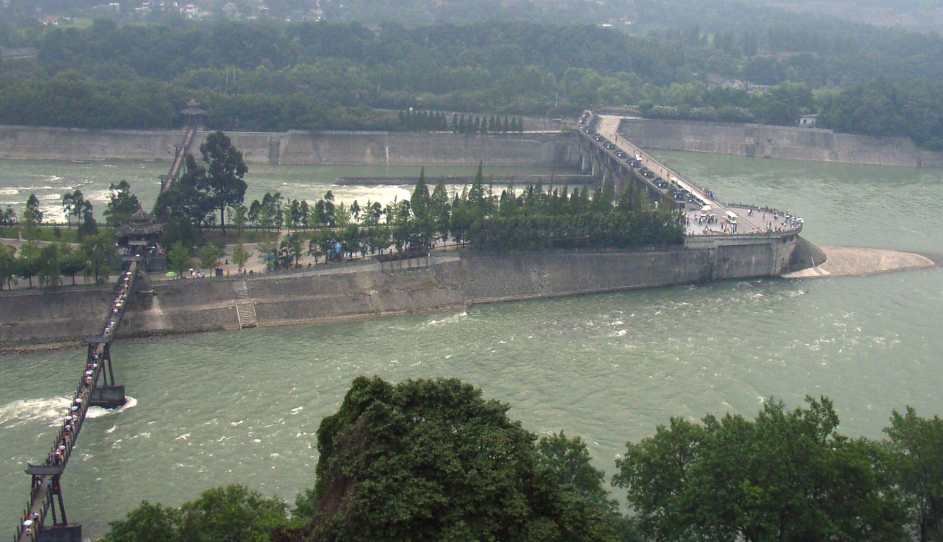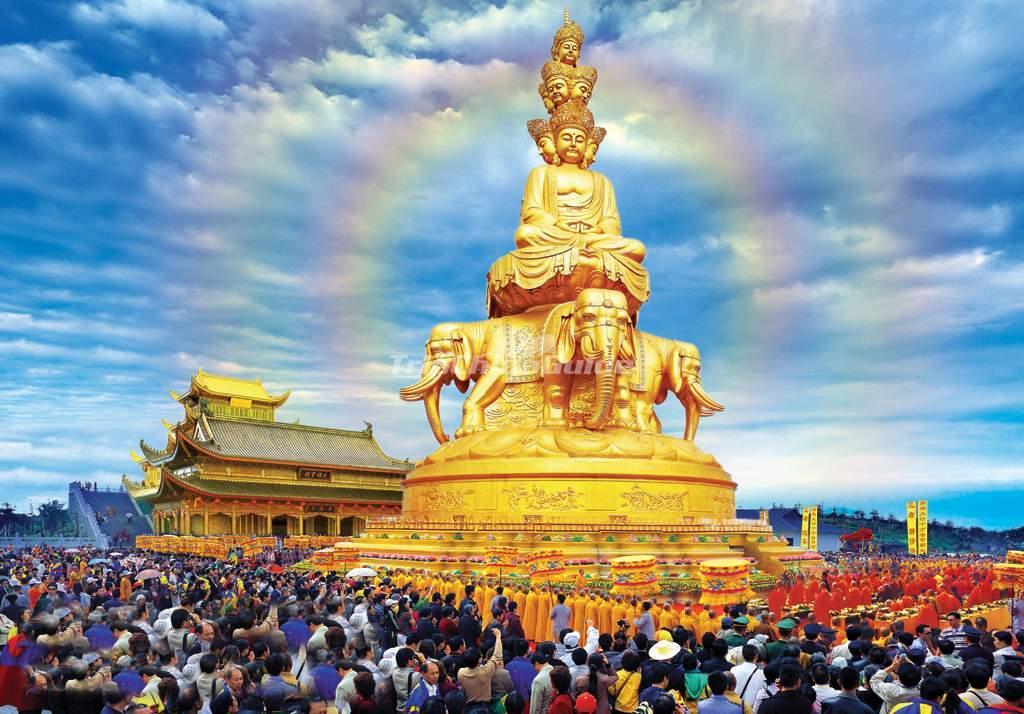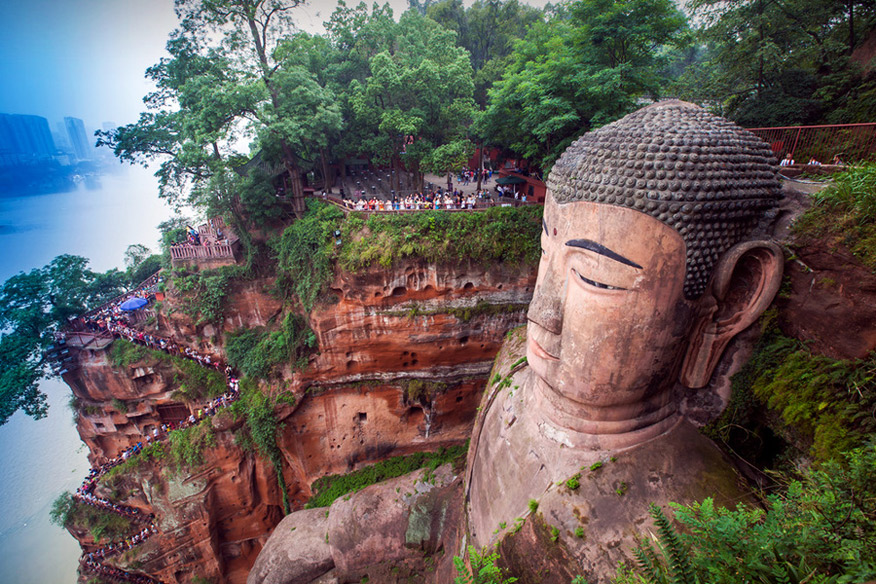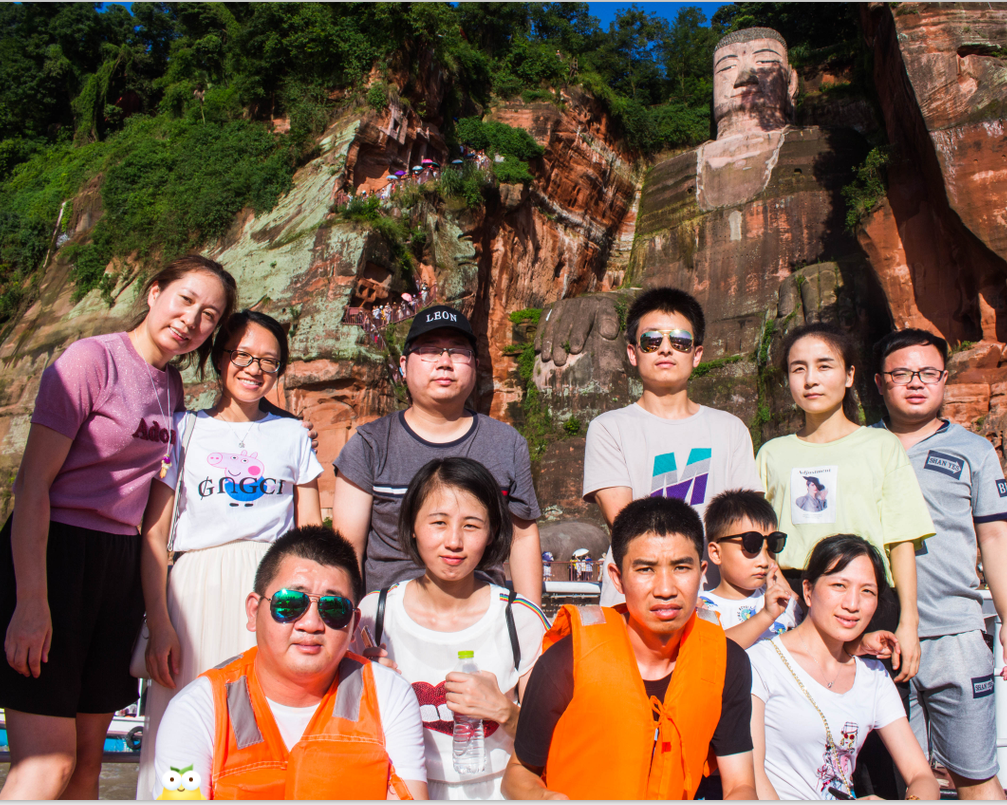Keep track of KONCAI people to visit Sichuan Province
Are you itching to touch adorable giant panda?
Do you want to admire miraculous Dujiangyan Irrigation System?
Have you challenged Mount Emei Climbing to see Golden Summit and clouds sea?
Are you always attracted by the grandness of sacred Leshan Giant Buddha statue?
Are you curious about what is Chengdu local culture and customs?
If you are longing to savor the scenic spots as above, please keep track of KONCAI people who took a company tour in Sichuan Province from August 8 to August 13, 2019.

During the 6 days, KONCAI Aluminum Cases Ltd visited all the wonderful historic and scenic places. Go there and use your imagination, maybe you will discover a new sight by yourself.
Day 1-2: Dujiangyan Irrigation System

Dujiangyan Irrigation System is honored as the “Treasure of Sichuan”, which still plays a crucial role in draining off floodwater, irrigating farms and providing water resources for more than 50 cities in the province.
In China, Chengdu is always praised as the Tian Fu Zhi Guo, which means 'Nature's Storehouse'. Over 2,200 years ago, the city was threatened by the frequent floods caused by flooding of the Minjiang River (a tributary of the Yangtze River). Li Bing, a local official of Sichuan Province at that time, together with his son, decided to construct an irrigation system on the Minjiang River to prevent flooding. After a lengthy study and a lot of hard work by the local people, the great Dujiangyan Irrigation System was completed. Since then, the Chengdu Plain has been free of flooding and the people have been living peacefully and affluently.
Dujiangyan is the oldest and only surviving no-dam irrigation system in the world; and a wonder in the development of Chinese science. The project consists of three important parts, namely Yuzui, Feishayan and Baopingkou scientifically designed to automatically control the water flow of the rivers from the mountains to the plains throughout the year.
Yuzui, like a big fish lying in the Minjiang River, is a watershed dividing the river into two parts: inner river and outside river. Feisha Yan is a spillway that diverts the sand and stones of the inner river into the outer river. Baoping Kou, like a neck of a bottle, is used to bring water into the inner river from Minjiang. At the same time, Baoping Kou controls the amount of the intake water due to its reasonable location. These three parts interact with each other perfectly to form an effective water conservancy project. During the low-water season, 60% of the Minjiang water is brought into the inner river for irrigation while 40% of the water is drawn into the outside river. The situation is reversed in the flood season ensuring the water supply for irrigation and protection from flooding on the Chengdu Plain.
Day 3-4: Mt. Emei Climbing

Mt. Emei is located in Leshan City, Sichuan Province. It is towering, beautiful, old and mysterious. It is like a huge green screen standing in the southwest of the Chengdu Plain. Looking its winding and beautiful figure, you will find that it resembles very much an eyebrow of a girl. It is the highest one among all the famous sight-seeing mountains in China.
On the mountain there are four scenic regions: Baoguo Temple(报国寺), Wannian Temple(万年寺), Qingyin Pavilion(清音阁) and Golden Summit(金顶). Its main peak, the Golden Summit, is 3079.3 meters (10,103 feet) above the sea level, seemingly reaching the sky. Standing on the top of it, you can enjoy the snowy mountains in the west and the vast plain in the east. In addition in Golden Summit there are four spectacles: clouds sea(云海), sunrise(日出), Buddha rays(佛光) and saint lamps(圣灯). In 1996, Mt. Emei was enlisted in the world natural and cultural heritage by the UNESCO.
Mt. Emei is a wondrous world. The trees are verdant almost all the year round; the waterfalls are splendid; the whole scenery is beautiful and quiet. The landscape varies according to the seasons, the height and the climate. The poet Tan Zhongyue(谭钟岳) living in the Qing Dynasty (1644-1911) once concluded the beautiful landscape in Emei Mountain into ten scenic sights(峨眉十景). Today more and more new scenery has been discovered and given beautiful names such as Listen to the Spring beside the Tiger Brook(虎溪听泉), Plank Road above Longjiang River(黑龙江栈道) and Flying Waterfall Hanging over Dragon Gate(龙门峡飞泉).

Mt. Emei has a long history. According to the archaeological material, people in remote ancient times have lived in this place. As early as 5,000 years ago, the Emperor Xuanyuan paid two visits here to learn Tao thoughts. 1,900 years ago, a practitioner built the first monastery here, thus marked the mountain the birthplace of Buddhism in Yangtze Valley. Today the Buddhist culture has become the main body of Emei Culture. The Buddhist architecture, music, grottos and paintings in the mountain all reflect rich religious flavor and culture.
Day 3-4: Leshan Giant Buddha

The Leshan Giant Buddha is a statue of Maitreya (a Bodhisattva usually represented as a very stout monk with a broad smile on his face and with his naked breast and paunch exposed to view) in sitting posture. The Buddha is located to the east of Leshan City, Sichuan Province, at the confluence of three rivers, namely, Min River(岷江), Qingyi River(青衣江), and Dadu River(大渡河). The statue makes itself the most renowned scenic spot in that city. In December, 1996, the location of the Buddha was included by UNESCO on the list of the World Heritage sites. Begun in the year 713 in the Tang Dynasty, and finished in the year 803, the statue took people more than 90 years to carve. During these years, thousands of workers had expended their efforts and wisdom on the project. As the biggest carved stone Buddha in the world, the Giant Buddha is featured in poetry, song and story.
Facing the river, the Buddha has symmetrical posture and looks which have been beautifully captured in its solemn stillness. It is 71 meters (about 233 feet) high, and has 8.3-meter-long (about 27 feet) fingers. The 9-meter-wide (about 30 feet) instep is big enough for one hundred people to sit on and the 24-meter-wide (about 79 feet) shoulder is large enough to be a basketball playground.

The charm of the Buddha lies not only in its size but also in its architectural artistry. There are 1,021 buns in the Buddha's coiled hair. These have been skillfully embedded in the head. The skill is so wonderful that the 1,021 buns seem integral to the whole. Another architectural highlight is the drainage system. This system is made up of some hidden gutters and channels, scattered on the head and arms, behind the ears and in the clothes. This system, which helps displace rainwater and keep the inner part dry, plays an important part in the protection of the Buddha. The large pair of ears, each seven meters (about 23 feet) long, is made of wood and is decorated by mud on the surface. For craftsmen of thousands of years ago, it was not easy to fix these to the stone head.
Day 5-6: Wide and Narrow Alley (Kuanzhai Xiangzi)

Consisting of Wide Alley (Kuan Xiangzi), Narrow Alley (Zhai Xiangzi), Well Alley (Jing Xiangzi) three parallel ancient city alleys and 45 courtyards along them, Wide and Narrow Alley is one of Chengdu’s historical and cultural reserves, together with Daci Temple reserve and Wenshu Monastery reserve. It is a microcosm of the city’s history as well as a deep mark in local people’s memory.
The history of Wide and Narrow Alley can be dated back to the Qing Dynasty (1644 - 1911 AD). At that time, the area was a city within the Chengdu city called Mancheng City or Shaocheng City, where the court quartered troops. As time passed by, the city decayed and only the Wide Alley and Narrow Alley were left. In 2003, renovation work of the two alleys began, aiming to build a complex cultural and business street with the functions of tourism and recreation. On June 14, 2008, the newly renovated Wide, Narrow and Well Alley were opened to the public, located in nowadays Qingyang District, to the east of Tongren Road and west of Changshun Street. Nowadays, Wide and Narrow Alley is a popular entertainment and nightlife block as well as a famous tourism site, with lots of restaurants, pubs, teahouses, and stores selling featured souvenirs.
Wide Alley exhibits the leisurely life of natives and represents the most typical forms of Chengdu folk culture. The unique attractive elements include the natives, old lodges, and ancient teahouses, etc, showing the modern Chengdu people’s memories about the city’s past.
The feature of Narrow Alley is the typical slow life of Chengdu natives. It mainly shows the courtyard culture of the city and courtyard dreams of Chinese people. There is a garden in a residence, a house in the garden, a yard in the house, trees in the yard, sky over the trees, moon in the sky. After renovation, the alley was decorated with bamboos, vines and traditional wall lamps.
Well Alley is the modern side of Wide and Narrow Ally, as well as the most open, most diverse, and most dynamic zone in the area. In this most beautiful historical block of Chengdu, one can taste the delicious food; among the most delicate traditional buildings of the city, one can entertain oneself in the colorful night; in the most typical alley of the city, one can enjoy the happiness of free thinking. The facilities here include pubs, nightclubs, dessert shops, wedding site, and retail shops. The most featured building here is a western villa. Originally a private residence and later a church, it is now a site for love and marriage consumption, and representative of sweetness and fashion.

KONCAI people also visited the panda base. Regretfully, it’s hot in August. All the panda are staying in the room with air conditioning. We can only watch them through thick glass wall.

